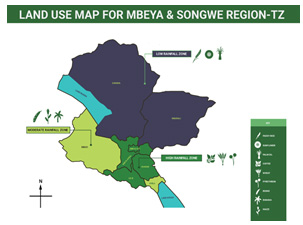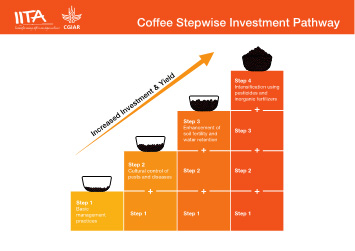Problem/challenge
Coffee is a tree crop, which requires good management throughout its growth cycles. Farmers are trained continuously in good agricultural practices to improve coffee productivity. The training offered to farmers introduces a “basket of practices” and climate smart technologies, which they are urged to implement all at once for sustainable coffee production and productivity. However, adoption of good management practices is still very low among smallholder farmers due to resource constraints. Application of all practices within the “basket of practices” poses challenges to resource-poor farmers who end up implementing them haphazardly with little or misguided planning on how best to break up the “basket of practices”, which in turn leads to low adoption and implementation as well as poor timing of recommended practices. Poor implementation of practices leads to low yields and leaves resource-poor famers poor if not poorer.

Demonstrating de-suckering; one of the recommended good management practices
What’s being done?
IITA in collaboration with public and private sector partners developed a set of complementary approaches and tools to explore the diversity of smallholder coffee farmers, their ranking of constraints to implementing Climate-Smart Agriculture (CSA) practices and land-use planning to identify different ecological zones within a country to enhance adoption of CSA and good agronomic practices among smallholder coffee farmers as well as make coffee farmers more resilient to climate change and its effects. One such approach, known as “Stepwise” (https://drive.google.com/file/d/1_LHX6caZuAQK6HM7vQ5k259W_n0h6yt_/view) breaks down the full training package of CSA practices into more manageable subsets of practices. These smaller packages are aligned with the structural (resource endowments) and functional (entrepreneurship) characteristics of different types of farmers.
A farmer segmentation tool (https://drive.google.com/file/d/114a5B-y0W2DcyRdasaNfIwIKtEwEd55x/view) differentiates the coffee farmers into sub-groups, based on their assets and entrepreneurial characteristics. These segmentations guide stakeholders working with farmers on how to best engage with and train farmers in the most relevant practices based on a contextually specific Stepwise for that agroecological area and sub-group of farmer by taking their capacity and willingness to implement the practices into consideration.
Successes so far
- Participatory Land use planning workshopsIn December 2017, two regional workshops were conducted with regional stakeholders in Mbeya and Kilimanjaro. Here, stakeholders were divided into groups in which they identified the major agroecological zones as well as map and update the main actors in CSA adoption and their roles in the major Arabica coffee growing regions of the country. Stakeholders included representatives from government, non-governmental organizations, civil society, academia and research, the private sector, and different associations from the regions. The output of this process was a set of land use maps that represented the different agroecological zones identified per region.


- Development of Stepwise
 IITA worked with various coffee experts to develop a national stepwise investment pathway for Arabica coffee in Tanzania. During the workshop, stakeholders were divided into four groups to develop pathways for both coffee types. The four investment pathways were then compiled into a hybrid (with expected yields estimated for each). Subsequent establishment of demonstration plots with impact partner participating farmers provided the testing ground for each site-specific stepwise climate-smart investment pathway. IITA researchers delivered a Training of Trainers to the impact partner extension officers. In Tanzania regular monitoring and data collection is done by HRNS with backstopping from IITA.
IITA worked with various coffee experts to develop a national stepwise investment pathway for Arabica coffee in Tanzania. During the workshop, stakeholders were divided into four groups to develop pathways for both coffee types. The four investment pathways were then compiled into a hybrid (with expected yields estimated for each). Subsequent establishment of demonstration plots with impact partner participating farmers provided the testing ground for each site-specific stepwise climate-smart investment pathway. IITA researchers delivered a Training of Trainers to the impact partner extension officers. In Tanzania regular monitoring and data collection is done by HRNS with backstopping from IITA. - Farmer segmentationAgricultural extension to farmers in Tanzania assumes similar needs and aspirations. Research reveals there are in-fact many variances between farmers. The farmer segmentation tool enables the researcher and impact partners to identify different clusters of farmers with similar characteristics. By better understanding specific farmer characteristics, more effective extension service delivery models can be targeted. Having identified the different challenges and resource constraints of the different farmer categories in Mbeya and Kilimanjaro, HRNS utilizes this knowledge to provide targeted extension services based on the specific needs and available resources of the farmers.
- Stepwise demonstrations
 Following the Stepwise climate-smart investment pathways developed by the regional stakeholders in the two major Arabica coffee growing areas in Tanzania, demonstration plots have been set up on HRNS participating coffee farmers plots: three in Mbeya and two in Kilimanjaro. The plots are set up based on the site-specific Stepwise investment pathways for each site. The aim of setting up the demo plots is to validate the approach and demonstrate to coffee farmers in these sites the combination of packages developed by the stakeholders as the best pathway through which farmers can implement CSA and good agricultural practices in Arabica coffee. The demo plots are monitored for their performance and data collected is being analyzed by IITA. Results are expected to be shared towards the end of 2019.
Following the Stepwise climate-smart investment pathways developed by the regional stakeholders in the two major Arabica coffee growing areas in Tanzania, demonstration plots have been set up on HRNS participating coffee farmers plots: three in Mbeya and two in Kilimanjaro. The plots are set up based on the site-specific Stepwise investment pathways for each site. The aim of setting up the demo plots is to validate the approach and demonstrate to coffee farmers in these sites the combination of packages developed by the stakeholders as the best pathway through which farmers can implement CSA and good agricultural practices in Arabica coffee. The demo plots are monitored for their performance and data collected is being analyzed by IITA. Results are expected to be shared towards the end of 2019.





No Comments